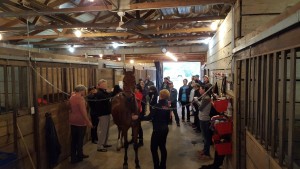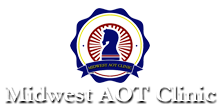In 2018, USEF implemented sweeping changes to the Amateur Owner Trainer rules for the Saddlebred breed. I was the author of those changes, and I submitted them because there were (surprisingly) no rules in the USEF rulebook for Saddlebred exhibitors! Many of our charter clubs had their own rules, but they varied from club to club, making it very confusing for exhibitors. The only “rule” USEF had was a casual mention of a horse not being in training for 90 days.
Here is the new rule as approved. This went into effect on 12/1/2017.
SB108.3 AMATEUR OWNER TRAINER (AOT) CLASSES
a. OWNERSHIP. Horses entered in AOT classes must be registered in the name of the competitor or a member of the competitor’s family, as defined by GR123. Combined ownership is not permitted unless all owners are members of the same family. Horses registered in a farm/ranch/syndicate/partnership/corporation name may be shown in AOT classes provided the family is the sole owner of the farm or entity as defined by GR123. In the case of a junior exhibitor, the parent or guardian must sign. Leased horses are not allowed unless owned by a member of
the competitor’s family.
b. CLASSES. AOT classes can be offered in any Saddlebred section. Horses may be stabled with a professional during the competition and hauled by a professional. Professional aid is permitted only in the areas of grooming, preparation, and ground assistance in the warm up ring and after judging is complete. Headers and in-ring assistants must be amateurs. Professional coaching in the warm up-ring and during the class is strictly prohibited in any class that the horse-rider combination compete in at the same show. Professional help for situations relevant to safety is
permitted. Owner must sign as owner, trainer and rider/driver on the Federation entry blank.
c. TRAINING. Horses are not to have been professionally trained for a minimum of 90 days prior to the start of the competition. Training includes, but is not limited to, in-hand work, lunging, long lining, driving, riding, and stall bridling.
 d. LESSONS AND CLINICS. AOTs may take lessons and attend clinics with their AOT horse, another horse owned by them, or any other horse. Trainers/instructors may demonstrate training techniques on the horse to be shown in AOT classes for the purpose of educating the owner. Training demonstrations are limited to no more than one instance per 30 day period, and the last instance cannot be less than 30 days prior to the start of a show. If more than one instance occurs in 30 days or one occurs less than 30 days before the start of a show, 90 days must pass from
d. LESSONS AND CLINICS. AOTs may take lessons and attend clinics with their AOT horse, another horse owned by them, or any other horse. Trainers/instructors may demonstrate training techniques on the horse to be shown in AOT classes for the purpose of educating the owner. Training demonstrations are limited to no more than one instance per 30 day period, and the last instance cannot be less than 30 days prior to the start of a show. If more than one instance occurs in 30 days or one occurs less than 30 days before the start of a show, 90 days must pass from
the last instance until the horse is again eligible for AOT classes.
About the Rule Change
As the manager of the Midwest AOT Clinic, I conducted a national survey of over 250 current AOTs and 70+ former AOTs. Of their top challenges, 39% stated finding help at home, 38% finding help at shows, 33% stated growing their skill level, and 32% stated fixing training problems. I believe these challenges present a very honest picture of why the AOT division is so small, and why it is shrinking in many parts of the country. The difficulties faced by an amateur trying to train and show a horse on their own are sometimes overwhelming, often leading to the decision to forgo showing altogether in favor of “easier” pursuits. Since 89% of survey respondents indicated they chose to be an AOT because they enjoy the personal interaction with their horse, putting the horse in training is not always a viable solution for them.
In addition, in my decades as an AOT boarding my horse at multi-breed/discipline barns, I have encountered dozens upon dozens of horse owners who used to ride and show Saddlebreds. Many of them had horses with trainers, while others had come up through Academy programs. The one common thread all of these owners had is that they no longer owned Saddlebreds or rode Saddle Seat. They left when they wanted the opportunity to be more involved with their horses but had somehow formed the belief that Saddlebreds have to be in training to be competitive. So they gave up on that dream and instead, settled for a different breed of horse or took their Saddlebred and started competing at open shows in a different discipline.
I believe this double-edged sword of AOTs deciding not to show, and people leaving Saddlebreds due to the desire to be more hands-on yet still compete, can be reduced by providing better opportunities for AOTs to receive the education and assistance they need. In that vein, I believe growing the AOT division will go a long way towards keeping people in the breed.
The rules aim to accomplish several things.
- Provide rules where there are currently none.
- Carve a path to education for the AOT.
- Reduce the loss of owners and exhibitors.
Here is a breakdown of how the proposed rules meet the three goals above:
CLASSES
“AOT classes can be offered in any Saddlebred section.” While AOT classes are mentioned in several places throughout the SB rules, it is not specifically stated they are available for every division.
“Horses may be stabled with a professional during the competition and hauled by a professional.” AOTs who board at a training stable or who are receiving assistance from a professional should be allowed to stable nearby and/or trailer with them for convenience and to minimize wasted time.
“Professional aid is permitted only in the areas of grooming, preparation, and ground assistance in the warm up ring and after judging is complete.” I realize that the Arabian and Morgan rules are the exact opposite of this, effectively prohibiting a trainer from assisting an AOT in any way; however, given the small (and shrinking) size of this division in the Saddlebred breed, any obstacles to getting exhibitors in the ring should be eliminated until such time as the division is large enough to support barriers to entry. In addition, since the spirit of an AOT class is amateur owner TRAINED, I do not believe minor activities such as assistance with grooming, holding the horse for mounting or hooking, taking down a tail, aid with putting on a tail brace, removing a pair of chains after warming up, or any other small area of service impedes on the act of the amateur as TRAINER. Nothing any professional can do in the areas of grooming or preparation will impact the PERFORMANCE of the horse in the class – and that is ultimately what is being judged. And finally, professionals are still prohibited from performing any act that is defined as “training,” and that is easily enforceable while on show grounds.
“Headers and in-ring assistants must be amateurs.” This rule serves to eliminate any perception of bias that might occur should a professional assist while judging is active. A professional can assist with a victory pass, since judging is completed.
“Professional coaching in the warm up-ring or during the class is strictly prohibited in any class that the horse-rider combination compete in at the same show.” As trainer of the horse, the owner should not receive guidance and instruction during active competition. Since the horse-rider combination could compete in other classes prior to or after the AOT class, this rule also dictates that coaching of the pair is not permissible in ANY class they are competing in together at the show.
“Professional help for situations relevant to safety is permitted.” This goes without saying. In an emergency, anyone should be allowed to help.
“Owner must sign as owner, trainer and rider/driver on the Federation entry blank.” This will certify that they meet the qualifications to enter AOT classes.
TRAINING
“Horses are not to have been professionally trained for a minimum of 90 days prior to the start of the competition.” The current rule states 90 days, and this proposal does not seek to change that.
“Training includes, but is not limited to, in-hand work, lunging, long lining, driving, riding, and stall bridling.” This provides a definition of training. As always, an AOT horse can be worked by anyone not meeting the definition of professional.
LESSONS AND CLINICS
“AOTs may take lessons and attend clinics with their AOT horse, another horse owned by them, or any other horse.” This is simply to state that AOTs are allowed to take lessons, on any horse, to further their skillset.
“Trainers/instructors may demonstrate training techniques on the horse to be shown in AOT classes for the purpose of educating the owner.” In the interest of educating AOTs, occasionally a trainer may need to demonstrate something versus trying to verbally explain it. I would not want a short demonstration to eliminate the horse from AOT competition, as that would defeat the purpose of educating AOTs. However, to prevent this from becoming an “in training” scenario, the next portion of the rule reads:
“Training demonstrations are limited to no more than one instance per 30 day period, and the last instance cannot be less than 30 days prior to the start of a show. If more than one instance occurs in 30 days or one occurs less than 30 days before the start of a show, 90 days must pass from the last instance until the horse is again eligible for AOT classes.” This part of the rule is intended to eliminate any gray areas about a horse being “trained” while it is in a lesson. I do not believe that a single demonstrative lesson by a professional in a one-month period is going to significantly impact the performance of a horse in the show ring, particularly if that instance occurred over a month prior to showing. Also, should the clinic or lesson take place at a show, the 30-day window automatically prohibits the trainer from riding or working the AOT horse.
As with all rules, it is up to exhibitors to maintain their own integrity and report violations. Policing any “at-home” rules can be very difficult compared to violations that occur on show grounds, but it is my belief that most exhibitors are honest and will compete with honor.
- New USEF AOT Rules for American Saddlebred Exhibitors - July 23, 2019

Wonderful clarification. So, can a professional give lessons to the AOT at other times during the show? Or give lessons to the AOT at home?
Yes, lessons in no way affect the status of an AOT.